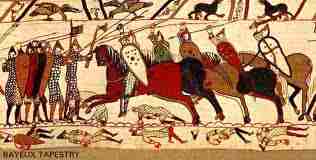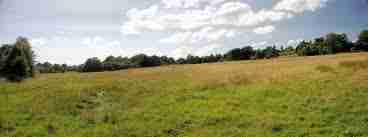 | > Other English exercises on the same topics: Literature | United Kingdom [Change theme] |
| > Similar tests: - Kate, Kensington Palace and Queen Elizabeth II - Around the world in 80 days - Wedding-Kate & William - William and Kate's Love Story - Vocabulary: elections - Scotland and culture - Vocabulary: laughter, humour - From Kansas City to Tulsa : What for? (1/2) | |
| > Double-click on words you don't understand |
Bayeux tapestry
Sorry, there are 2 typing mistakes in the word succeeded; one at 2mn10s and one at 2mn25s.
| England 1066 |
Early in 1066, Edward the Confessor, King of England died. He had no son to take over the
|  Edward the Confessor (1004-1066) |
Harold, Earl of Wessex, Edward's brother-in-law, was immediately crowned king. | King Harold (1022-1066) |
But Harold had sworn allegiance to William and had recognized him as the future king. | 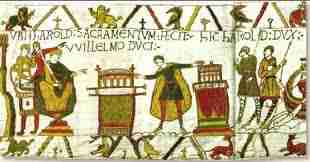 Harold's Oath of Fealty to William of Normandy (1064) |
Bishop Odo of Bayeux advised William to build a fleet and embark for England | 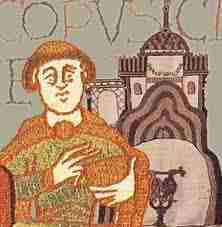 Odo of Bayeux, William's half-brother. |
| William landed in England on 28 September 1066, at Pevensey near Hastings. He established a camp. Soon after, Harold and his army arrived.
The Battle of Hastings occured on 14 October 1066. It lasted most of the day. Harold was killed | 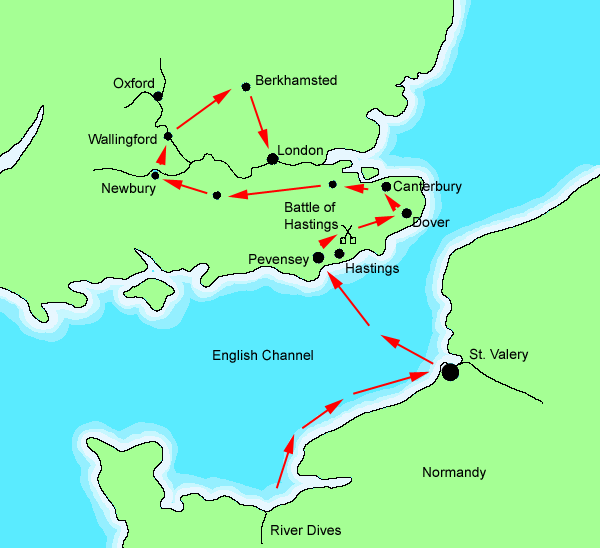 |
On Christmas Day 1066, William was crowned king in Westminster Abbey. | 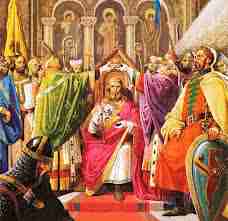 Coronation of William the Conqueror |
| The Bayeux Tapestry |
The Bayeux Tapestry is neither a tapestry nor a woven cloth. It is a long embroidered cloth (50 cm x 70 m) It tells the story of the Norman conquest of England The tapestry may have been commissioned by Bishop Odo and was | 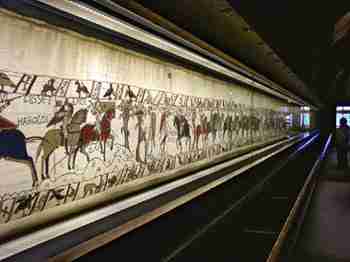 |
 |
Decorative borders along the top and bottom portray scenes from fables, farming, hunting and mythological figures such as lions and dragons. |  |
Bishop Odo went with William on the expedition. He is shown blessing the food and drink. (2:15) | 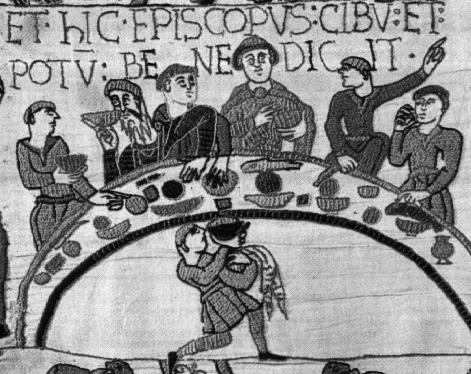 |
They built a Motte and Bailey castle (2:19) A 'motte' is a hudge mound of earth with a keep or tower on the top. A 'bailey' is like a little village at the bottom of the motte where men, provisions and horses | 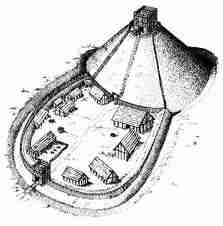 |
The Norman Knights had horses unlike the English who were on foot. (3:16)
|
|
Harold is crowned king despite his oath to William. | A Motte and Bailey castle is built for defense. A house is burnt down to make way for the Norman army. William prepares for battle. The Norman army advances. The Normans outflank the Saxons. Lewine, brother of Harold, is slain. Both Saxons and Normans fall in the raging battle. William rallies his troops for a final charge. King Harold is killed in the battle. The Normans are victorious. |
| Harold's and William's armies met on Senlac Hill, 10 km from Hastings. |

🎬 Help: how to see videos
English exercise "Bayeux tapestry" created by lili73 with The test builder. [More lessons & exercises from lili73]
Click here to see the current stats of this English test
End of the free exercise to learn English: Bayeux tapestry
A free English exercise to learn English.
Other English exercises on the same topics : Literature | United Kingdom | All our lessons and exercises


